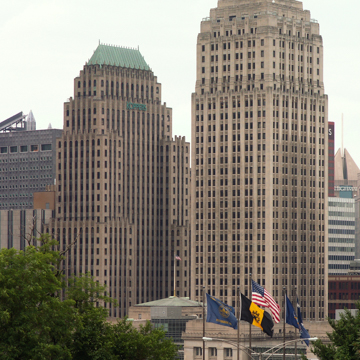The relocation of the Pennsylvania Railroad freight yards in 1927 gave new life to what for generations had been the blighted corner of Grant Street and 7th Avenue. In the space of five years, Andrew Mellon masterminded the construction of four key buildings at the corner: Koppers; the Art Deco building for the Pittsburgh branch of the Federal Reserve Bank of Cleveland (1930–1931, Walker and Weeks with Hornbostel and Wood); and the forty-four-story Gulf Building (1930–1932) by Trowbridge and Livingston, who also designed the massive U.S. Post Office and Federal Courthouse (1930–1934) on the remaining corner of the block.
Mellon could pull off this pharaonic-scaled patronage because he and his brother, R. B. Mellon, were chief shareholders in Koppers and Gulf, while he was at the same time secretary of the Treasury. To keep everything securely in the family, Mellon used his nephew Edward Purcell Mellon (1875–1953) as supervising architect for the Koppers Building and the family's Mellon-Stuart construction firm to build it. Mellon was probably also remembering the architectural ambitions of his friend Henry Clay Frick, who in the previous decade, had begun to line Grant Street with office towers. Even the choice of the architects was meaningful: they were the direct successors to Daniel Burnham, Frick's favorite architect.
But times had changed since Frick was building. In 1927, it was Art Deco and not Beaux-Arts that was the reigning style, so Koppers took on an appropriately streamlined image. Rising thirty-five stories with two setbacks, the first three stories of Koppers are polished gray granite, while the tower is Indiana limestone. Plain gray ribs exaggerate the building's height, and the spandrels sparkle with low-relief geometric designs. The final luster comes from a Chateauesque copper roof that is spotlighted at night in a dramatic green glow. The interior, too, is a jewel. The three-story lobby has cream-colored Italian marble walls veined in pale brown with a greenish tint, and a parquet floor in pink and gray Tennessee marble. A flowerlike design in cast bronze unifies elevator doors, directory panels, clocks, and balcony railings throughout the building. In the manner of the times, the cast-bronze mailbox is a miniature of the building, roof and all.


